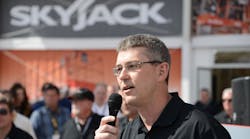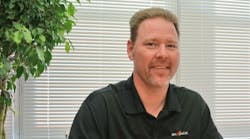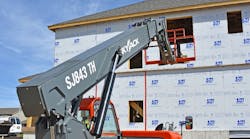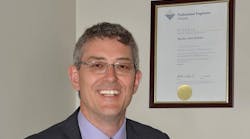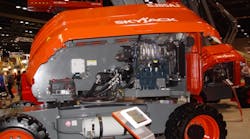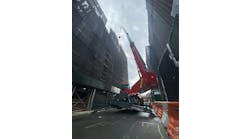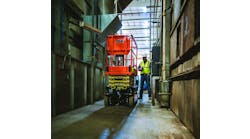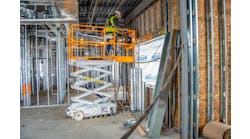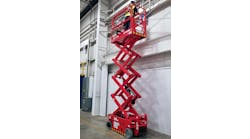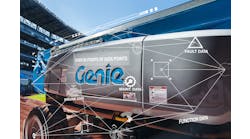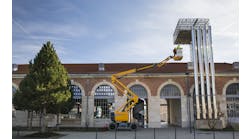As president of Skyjack, a sector board member of the Association of Equipment Manufacturers, and one of the most active members of IPAF, Brad Boehler rarely sits still for very long. Still, RER was recently able to catch up with him and talk about Skyjack’s growing equipment portfolio, the incoming ANSI standards, the potential for growth in the access market, and more.
By Michael Roth, rer
RER: What are some of your new products?
Boehler: We have some new products that we introduced last year that have been very well received. The electric 30 AJs and the SJ 4740 launched in the last 12 months and have settled into production. We’ve got a really positive book of pending orders for these products and that’s good. Beyond that, we have introduced telehandlers in the last year and they’ve gone over quite well, exceeding our launch expectations: 6,000 pounds, 8,000 pounds and 10,000 pounds. Our new 12,000-pound machine is now on the market also.
This year we launched the SJ85 AJ articulating boom at ARA and production is on track for June deliveries.
In the pipeline (launch early 2018), there will be a small 5,000-pound telehandler as well and that will round out our telehandler line from 5,000 pounds through 20,000 pounds.
2018 is going to be an interesting year! Dependent on when the new ANSI standards get published, there will be a phasing in of AWP products that comply with the new standard. We have revisited every product and it could be argued that these may not count as new product introductions. However, in our case we have taken the opportunity to revisit certain features, so that the new range features some significant improvements outside of the requirements of the standard. For Skyjack these changes and the improvement on customers ROI, which they deliver, are exciting…watch this space
What changes will there be to conform to the new standards?
The main changes are seen in six main areas…
- Naming – The design portions of the ANSI A92.3/A92.5/A92.6 standards become ANSI A92.20for equipment design. An Aerial Work Platform (AWP) becomes a Mobile Elevating Work Platform (MEWP).
- Load Sensing – most machines will actively monitor load and NOT operate with normal functionality if loaded beyond rated capacity.
- New Wind force requirements – Increased weight and reduced capacities in outdoor/wind conditions.
- New stability testing requirements - expect to see foam filled only (no air filled tires) on the vast majority of RT scissors and RT booms under the new standard (Booms and Rough Terrain Scissors). Flotation tires not feasible.
- Entrance gate with toe boards replaces chain entrance on electric scissors and vertical masts. Toe boards at entrances on booms.
- Railing Heights: Compact DC scissors now mostly equipped with folding instead of fixed rails.
What else is on the horizon for Skyjack?
What I talked of earlier is the immediate future, in the next year and a bit. Beyond that we have a portfolio plan that means we’re going to continue to broaden and refresh our product ranges. There will be another 40-something foot electric jib boom and there will be a 20-foot vertical mast somewhere in there. We’re going to re-design our entire rough-terrain scissor lift line and refresh some products to maintain and improve the ROI opportunity that the Skyjack range has long stood for.
Have they finalized the Stage V requirements?
Not fully but Stage V engines are looming and that represents a significant project in its own right that will demand some innovation on power sources and engineering approaches. At Skyjack we have always looked to protect the ROI equation and in practice that means looking at features that can assist in offsetting some of the cost increases that these standards often mandate. We saw that in telehandlers with the innovation of SMARTTORQUE engines with lower horse power but that maintained performance and controlled cost.
I would add that in all of these things we need to be sure we are not losing sight of who we are and how we do it, and provide a return on investment for our customers by giving them products that are competitive in initial price and very low cost of overall ownership. Retaining residual value so they can make money on their investment and their asset because people are optimizing their fleets and optimizing their costs around their fleets. Really the rental business is just a big asset management business. So it’s whoever can manage their assets most efficiently and get the most customers wins. We need to be in that equation helping those renters to do that. The two things I always tell everybody is focus on Return on Investment for our customers and be easy to do business with. If we do that Skyjack will prosper.
How many countries is Skyjack in?
That’s a good question. If you look at countries that we actually have legal entity and representation in, that’s Canada, United States, Brazil, United Kingdom, France, Sweden, Germany, China and Australia. We’re going to add Korea very soon, we already have people on the ground in Korea, we just haven’t formed a bricks-and-mortar entity yet but we’re in the process of doing that. We have a sales rep in the Benelux, no bricks and mortar but that might not be far behind either. There are probably a few other countries in that same vein. And we’ve sold equipment into other countries. We’ve sold equipment all over the European Union whether we have an office in a particular country or not, various countries in South America, into the Middle East and various parts of Asia as well. So those things are growing.
We have target market shares in the markets we’re already in, that we’d like to achieve and we have some markets that we’d like to enter as well, so there are still lots of opportunities for growth -- product growth, customer growth, market share growth…more overall growth, period. Our competitors may have a better foothold in some of these areas but as I look at our performance in our mature markets, our identity and subsequent sales are building, I think we can leverage our brand throughout markets. There is significant opportunity for us globally.
Some of those companies may have overspent in China.
There is one philosophy that the only way to be successful there is to be bullish and invest (some would argue to over invest) for quite some period of time, build up that culture, reputation and brand image, so that when the market does take off, those people who have stuck to it are the people who are going to benefit in China. That may be true and in some ways we have to catch up to that a little bit, hopefully before things do take off. But our approach has been to invest in what is needed to support the development of a “core” and to serve and not over promise to that core. Doing things right…keeping the ROI equation balanced and being easy to do business with will pay equal and important profitable dividends. When things do take off, China’s has huge potential, but things have to change there before any of that will come to fruition. The adoption of the rental business model, health and safety and policing. One can never be sure how quickly those things will change.
Two years ago I spent a week in Shanghai and went to the exhibition most days but had a couple of days where I wandered and visited customers. Very specifically Malcolm [Early] and I were down in the Bund area, and we walked back to our hotel. We walked through a lot of construction as well, new construction and the kind of places where in any other established market when they are putting up a 50-storey building you would see any number of pieces of equipment on that site, especially scissor lifts. They are usually on every floor, five or six scissor lifts. I didn’t see a single aerial lift or a single telehandler in downtown Shanghai. I saw two boom lifts the entire week outside of the exhibition space where everybody was exhibiting, and they were on the last day as we were leaving, at the airport.
So if you’re looking at it, Shanghai is China’s most progressive, forward-thinking city, most westernized city if you want to call it that, and they are building 50-storey buildings with little AWP equipment. They do have cranes. At one point where we drove back to the airport, I’m looking out of the cab and I counted 36 tower cranes that I could see at one time, and there was more, I just quit counting. There were no aerial lifts anywhere.
They were using scaffolding?
Scaffolding, ladders, buckets, you name it, but not any aerial lifts. I don’t see that changing until the government says “you shall do this” or the price of labor gets high enough that you can actually point to productivity gains by putting people on lifts; that you will save money by investing in them. Eventually they will have to do it. Between labor and the cost of injuring people you get to the point where it makes sense because it makes sense everywhere else in the world. That could be next year, that could be five years from now, it could be 10 years from now….hand me my crystal ball!
Overall worldwide there is space for the aerial market to grow.
Yes. The access equipment market is continuing to grow and there’s great potential in a lot of places that have yet to discover the productivity and safety gains that you get from having access equipment available to workers in various facilities. But again things seem to be moving along quite nicely, things seem to be moving along nicely in Europe as well right now, so there are a lot of good markets right now and a lot of activity going on so I’m enthused.
How has the response been to the 1056 and 1256 telehandlers?
Very good. We introduced the 1256 for the first time at World of Concrete and then at the Rental Show. But the telehandlers as a whole, having introduced them in late 2015, did very very well last year. We gained a significant amount of market share in a market that was down in North America….as I mentioned earlier, exceeding our launch expectations…it’s nice to be serious about telehandlers.
The 85-foot boomlift, what do you feel it has that is unique to its class?
It’s a Skyjack machine to start with, it has that simplicity. It’s got that reliable robust easy-to-maintain footprint that we have with everything. We looked at a variety of other different articulating booms because there are many ways to articulate them to get them into the air. You can create risers that are more like scissor stacks, you can create risers that are like a small zed pattern or even just an L. We did the groundwork for what we thought the best method of achieving that was going to be when we did the 63 AJ a few years ago. So I’d say the 85 is just an extension of that, it’s got a similar open-knuckle geometry on the riser. Then again it’s got the ability to get up and down from full height with just the extension boom as well. So the geometry is such that at full riser height you can manage to get yourself at full height with the extension as well as get all the way to the ground with your quickest ground to height timing as well. If you’re re-loading supplies or you’re going for lunch, it’s quick.
The 63 AJ was successful and class leading…its big brother the 85 AJ promises much of the same!
Operation is simple as far as understanding the controls?
Yes, it’s got a few other features that are common to the rest of our booms. You’ve got directional drive and steer control, which is different from our competitors. So there are no arrows on the chassis, there is just an expectation that if I’m facing that way, and my wheels are aligned, I’m just going to push my stick and go away from myself. That’s something I’ve never been able to figure out in the industry -- when you push a joystick away from you, the machine goes the other direction. That doesn’t compute with me. We’re always going in the direction that is the direction in which you push it. So that’s different from Skyjack.
The other thing that’s different from us on this boom and the same with all of our other booms, is the axle drive. We’re very particular on the fact that that gets better performance on booms, the life of the machinery is better, the cost of maintenance is better. That axle is lightly used on our machinery. You shouldn’t have to do anything other than grease it for the life of the machine. A little less maintenance is required and better performance, we’re very much convinced that you get better gradeability, terrainability, access around unimproved jobsites with axles under the machine and direct mechanical linkage to the ground.
What do you think will be the hardest part of the new ANSI standards?
Education, Education, Education. Whatever the reasons behind the changes (and there are many good reasons) the rental company cannot get a higher rate, the operator will have to be taught about new systems and practices. The big changes are training and load sensing. Skyjack needs to educate rental companies on the changes and what they mean for their customers operationally – train the trainer as it were. On the issue of load sensing methodologies differ by machine, but if you’re laying a load on a platform the machine will have to determine whether or not it’s overloaded. That’s going to be very new to the North American marketplace. I’m not worried about it from a technological standpoint, or from a “can we achieve methods of doing that?” standpoint. We’ve been doing that in Europe for almost 15 years now. It’s a matter of how confusing is that going to be for our customers and their customers who have never experienced it before.
So the customer has this machine that he is using now and he can overload it --which he shouldn’t do by the way -- but he might be overloading it and it still works. Then we sell him this machine tomorrow and he puts that same load of bricks or tools or whatever he put on it, but now that one won’t lift. So he calls us and says “So what’s wrong with my machine, it won’t lift?” That’s what we’re going to get, that’s what the rental company is going to get, that’s what they’re going to come to us and say. So we need to educate everybody about what the standards are calling for. We started that process with our recent Whitepaper on the subject (See www.skyjack.com).
The standards are not yet published, they are going through a balloting process and it is undetermined as to when they will be published. The way the standards are written, once they are published, manufacturers have a year of grace after that to catch up to the standard. So we can manufacture machines to either standard for a year period essentially. So we’re talking to our customers about what they envision going forward and whether they will want to immediately go to new standards machines or whether they’ll want to get old standards machines for as long as they can.
And that’s a commercial decision that they have to make and we have to make a commercial decision on when we cut production on various models and we’re looking and trying to educate our customers today on where we go from there.
So in the interim some customer might come and say “we want 50 units of the old standard” because they’ll be less expensive.
You’re right and it would be between us and them to determine how to fulfill that request within the standards, that’s why we need to know their desires. If they give us a purchase order today for all of next year saying ‘We want you to build stock of all these old machines for us, because that’s what we want because we believe that’s where the market’s going to go,’ then that’s where we’re at. I prefer to get all new-standard machines out as quickly as we can, but again we have to listen to what our customer base desires as well.
However, as I noted before we have approached the designs to bring the ROI equation back in balance. It costs us more and while we look to mitigate as much of that cost as possible it’s not always going to happen. So the rental company says I cannot get any more money for that machine, why pay more? Our approach has been that we will introduce several new features that look to improve operation, reduce pain points that we have been informed about and increase productivity….to me that’s the right thing to do for the industry as a whole.
